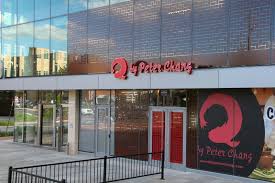That, in truth, was a consoling simplification. Americans have traditionally been willing to pay through the nose at French or Italian joints (where, in fact, Latinos often do most of the cooking). And every city has its pricey sushi bars and exorbitant tapas restaurants (tapas, as one joke goes, is Spanish for “$96 and still hungry”).
事實上,這是一種令人寬慰的簡化。傳統上,美國人總是愿意花大價錢去法國或意大利餐館(實際那里的大部分菜都是拉美人做的)。每個城市都有昂貴的壽司店和昂貴的西班牙小食館(西班牙小食館,就像一個笑話說的那樣,西班牙語的意思是“花了96美元但還是很餓”)。
But Mr Huang is right that Americans have long expected Chinese food to be cheap and filling. One step up from the urban takeaway, with its fluorescent lighting and chipped formica counter, is the stripmall bistro with its imposing red doors and fake lions standing guard—sufficiently exotic to be special, but still affordable enough for a family to visit once a week when nobody feels like cooking.
但是黃先生是對的,美國人長期以來一直期望中國的食物便宜又可口。在配備熒光燈和有缺口的富美家柜臺的城市外賣餐館的樓上,是一家小型酒館,它有氣派的紅色大門和守衛的假獅子——有足夠的異國情調,很特別,但仍然足夠經濟實惠,沒有人想做飯的時候,一個家庭每周去一次。
American dreams
美國夢

Even the superior outlets were cheap for what they served (and often still are). Consider the hand-ripped noodles with lamb at Xi‘an Famous Foods in lower Manhattan. A tangle of long noodles, each about the width of Elvis Costello’s ties in the late 1970s, is tossed with curls of braised lamb and a complex, incendiary sauce laced with cumin and chillies—all for just over $10, a fraction of the price of comparably accomplished dishes at smart restaurants nearby. True, Xi‘an Famous Foods has no waiters (diners carry their plates on plastic trays to bench seating). But its noodles are handmade, and the lamb dish may be the single best thing to eat in New York at any price.
即使是高檔餐廳的服務也很便宜(現在仍然如此)。以曼哈頓下城西安名吃店的羊肉扯面為例。一堆長長的面條,每條都有埃爾維斯·科斯特洛在上世紀70年代末的領帶那么寬,上面撒著一卷卷的燉羊肉和一種混合了孜然和辣椒的辣醬,所有這些菜的價格僅略高于10美元,與附近的高級餐廳里同樣精致的菜肴的價格相比,只是九牛一毛。的確,西安名吃沒有服務員(用餐者自己把盤子放在塑料托盤上拿到長凳座位上)。但它的面條是手工制作的,而羊肉可能是紐約不論價格高低最好吃的食物。
But now things are changing. Mr Huang sells deliciously pillowy stuffed buns in New York and Los Angeles for $5.50 each—or, as he puts it, “full fucking price”—and encourages other immigrants not to undervalue their work. Restaurants in Q’s bracket are cropping up not just in America’s Chinatowns but in the suburbs, where Chinese immigrants and their families have settled, following the classic strivers’ path. The median income of Chinese- Americans’ households is nearly 30% higher than the average. They are more than twice as likely as other Americans to have an advanced degree.
但現在情況正在改變。黃先生在紐約和洛杉磯賣美味松軟的包子,每個5.5美元,或者,用他的話說,“全價”,黃先生還鼓勵其他移民不要低估他們的工作價值。像Q這樣的餐館不僅出現在美國的唐人街,也出現在郊區,這里是中國移民和他們的家人定居的地方,他們遵循著經典的奮斗之路。美籍華人家庭的收入中位數比平均水平高出近30%。他們擁有高學歷的可能性是其他美國人的兩倍多。
譯文由可可原創,僅供學習交流使用,未經許可請勿轉載。












